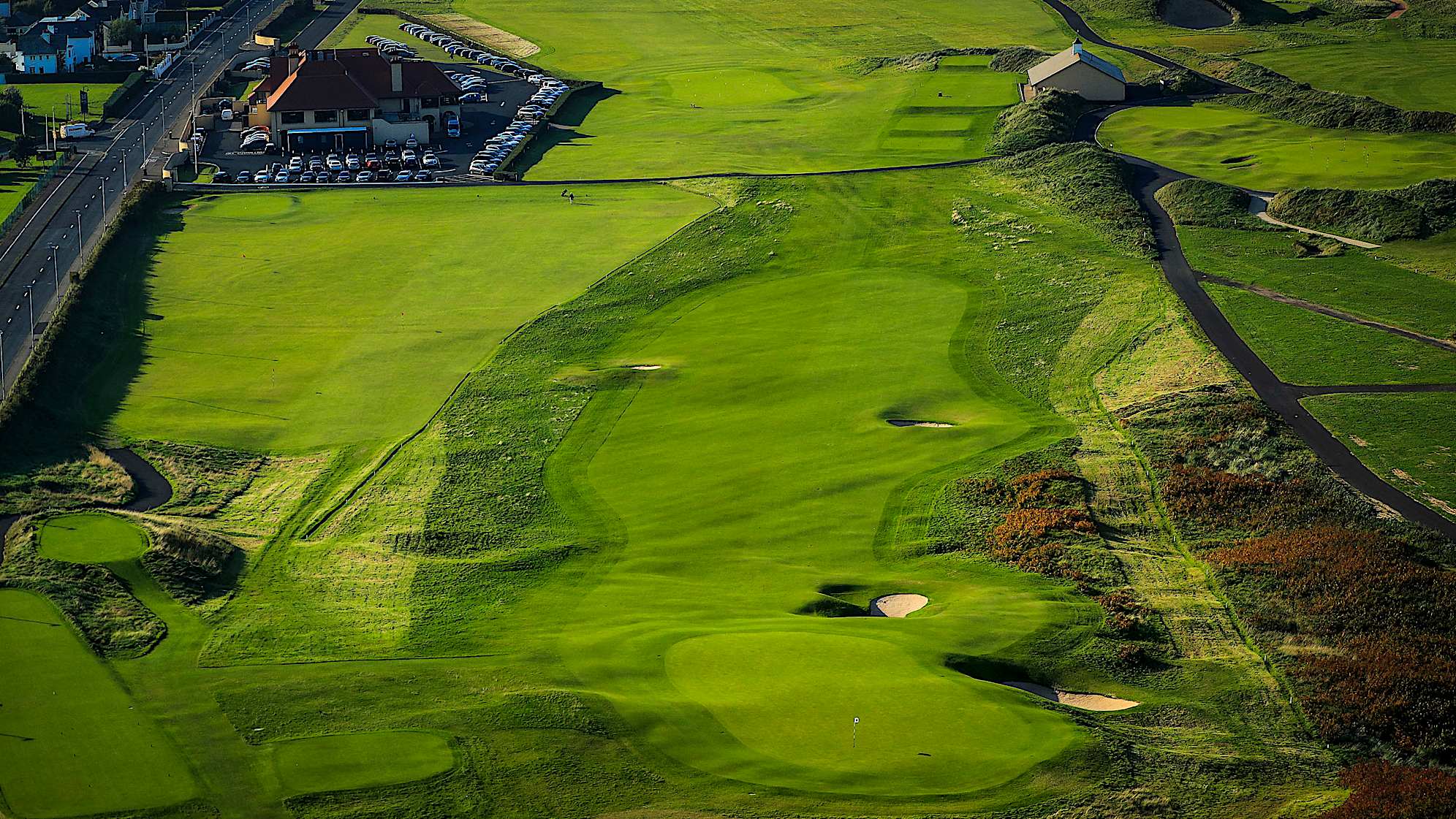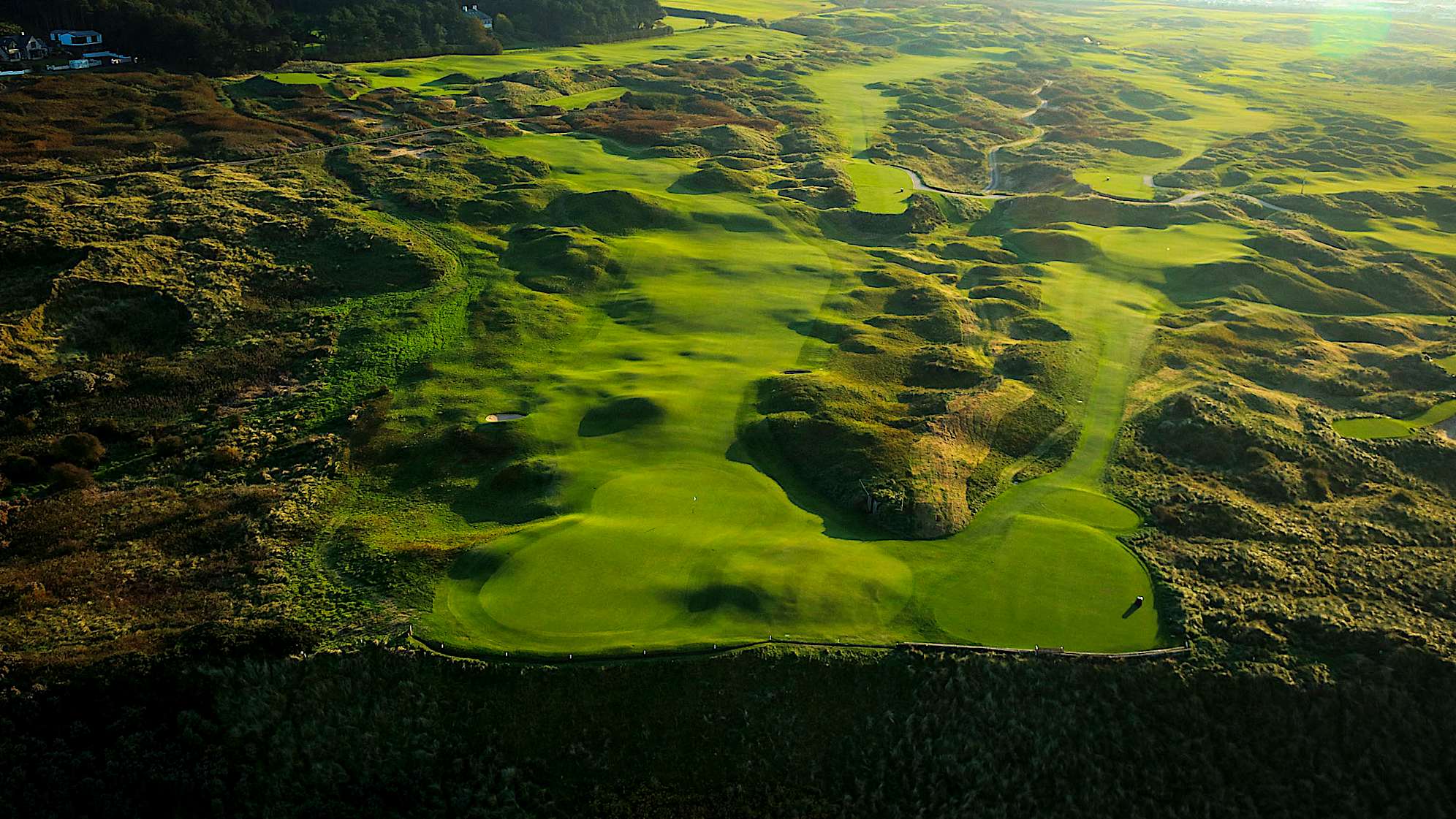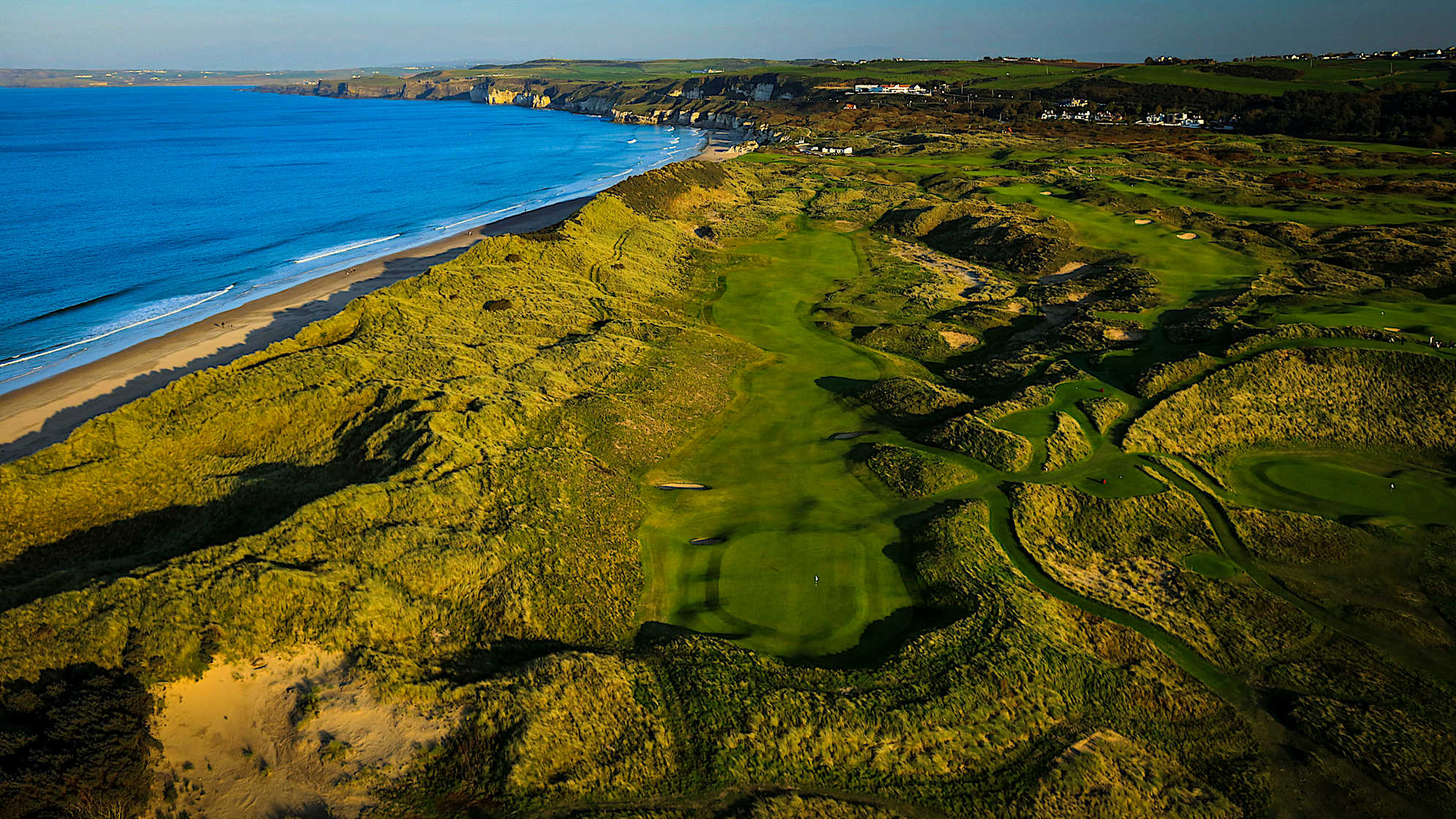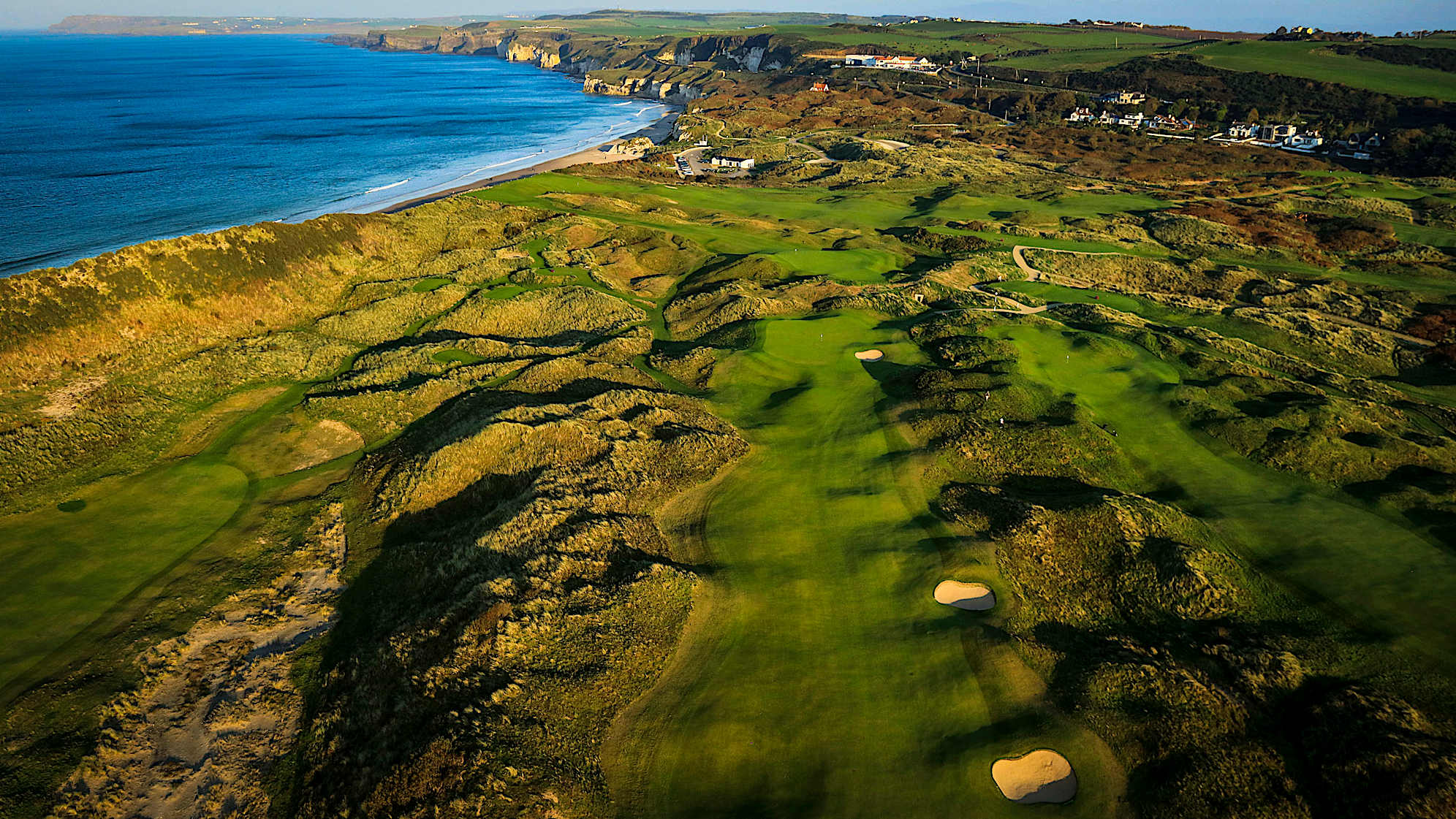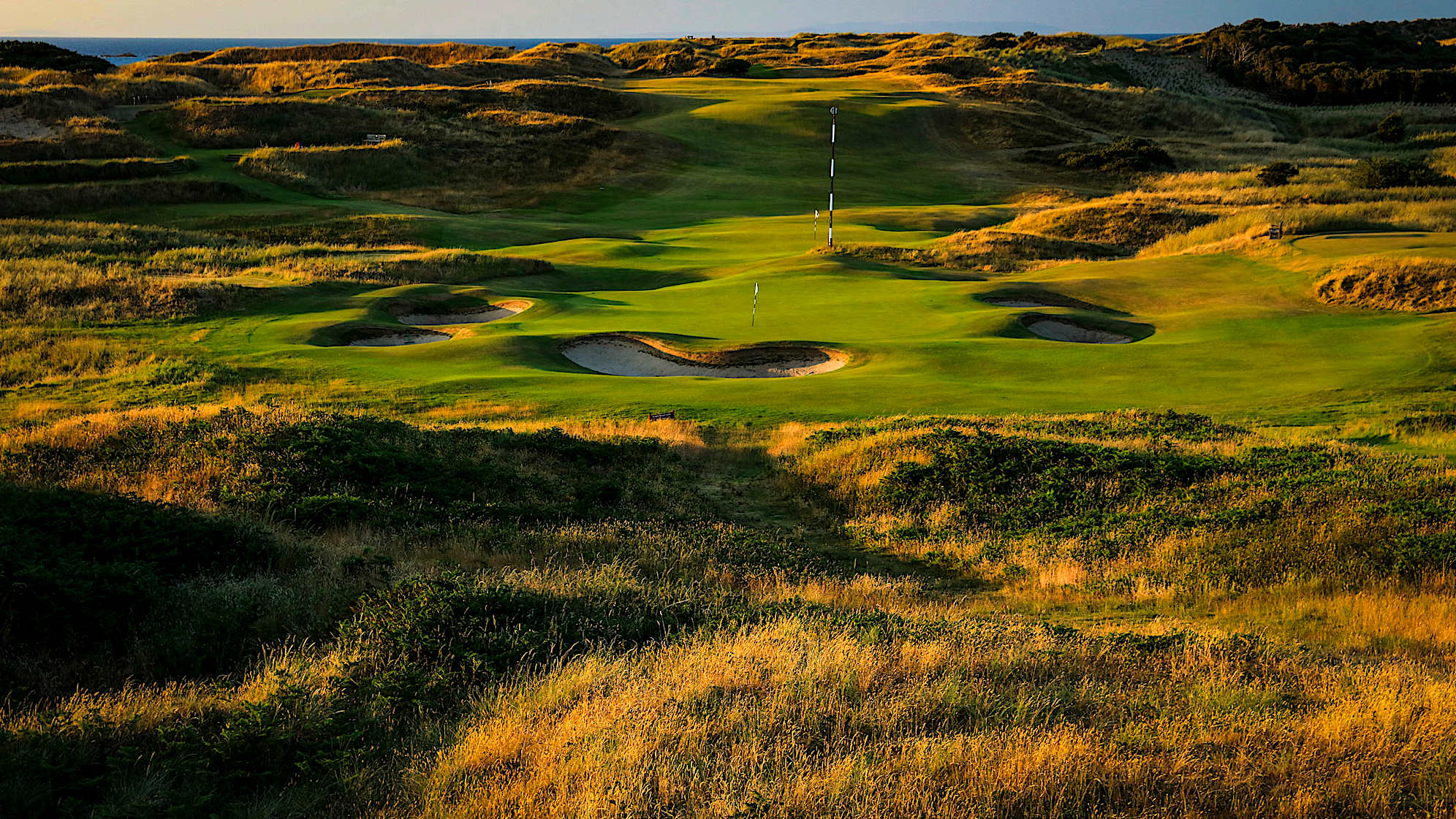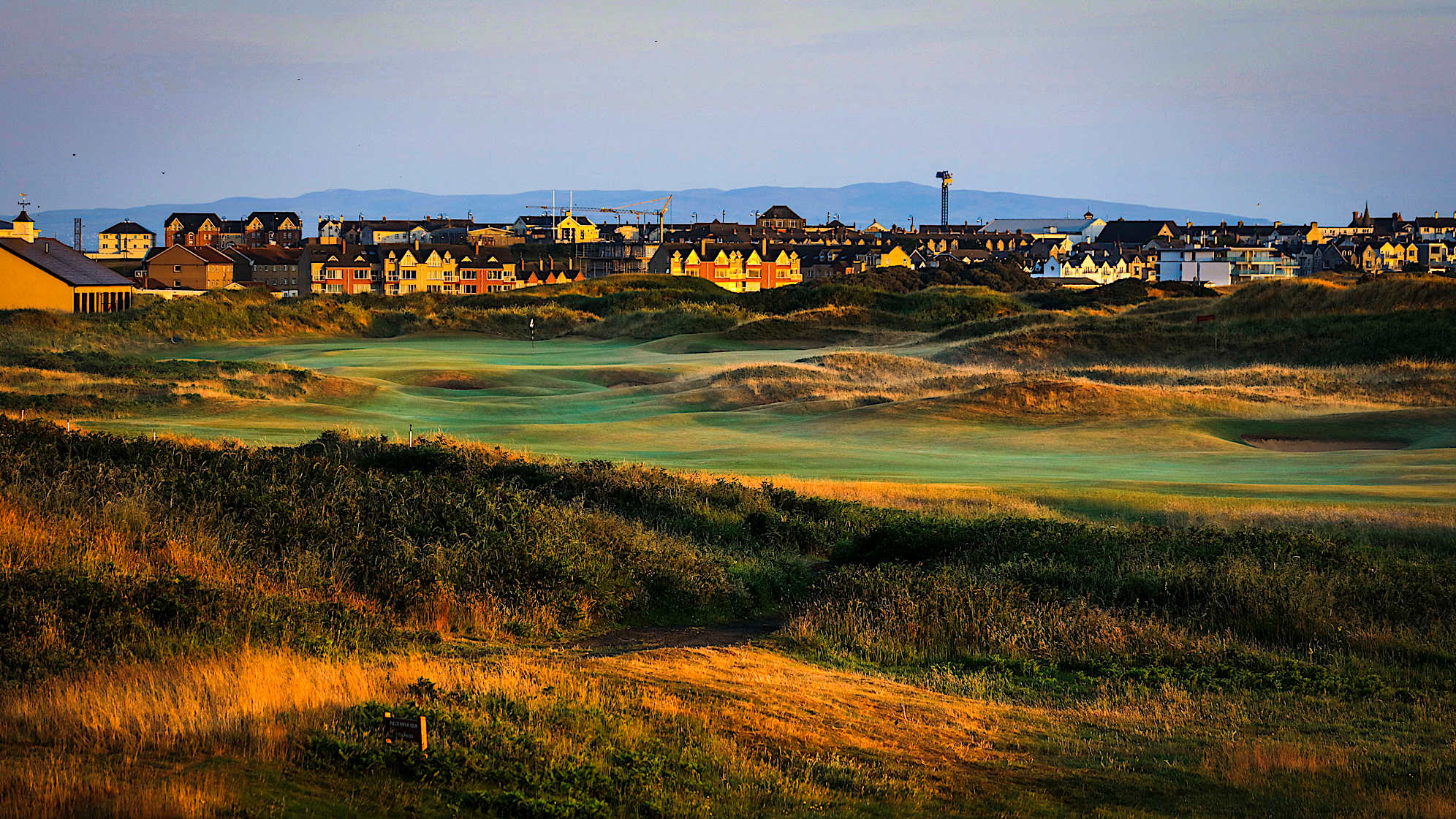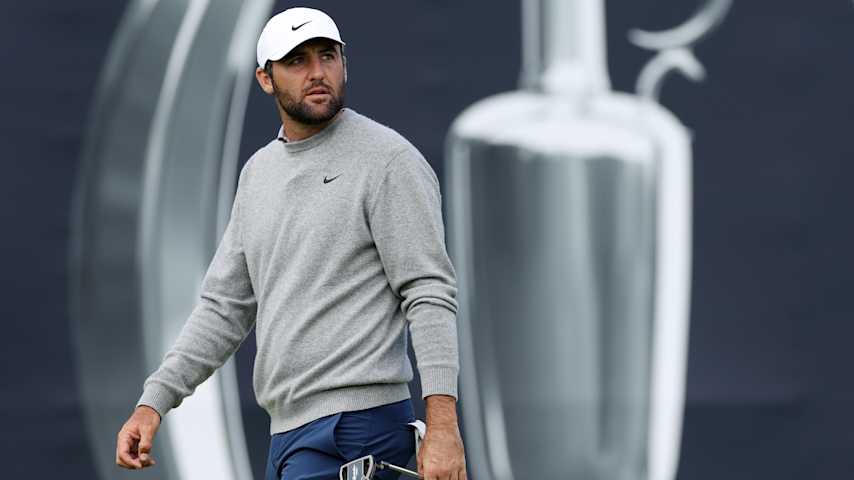Royal Portrush: Nine things to know about host of 153rd Open Championship
12 Min Read

Shane Lowry's home club reacts as he wins The Open at Royal Portrush in 2019
Written by Bradley S. Klein
The Open Championship is being played outside Great Britain for only the third time in the event’s 153-year history. On each occasion – in 1951, 2019 and now 2025 – the venue beyond conventional shores has been Royal Portrush Golf Club – Dunluce Course in County Antrim, Northern Ireland. Ahead of golf’s return to the dramatic seaside links, here’s a look behind the scenes at the course and the setting.
1. Northern Irish Links
When talk of British links golf arises, the association is usually with more well-traveled destinations like Scotland’s Fife Coast, the stretch southwest of Glasgow, or East Lothian, just beyond Edinburgh. Down south in England, the bulk of attention goes to the run of fine northwest coastal courses from Liverpool to beyond Blackpool, or the Kent Coast along the English Channel.
This year’s Open Championship is a reminder that the northeast coast of Northern Ireland is equally strong in terms of links golf. You could easily spend a memorable week simply indulging in the likes of Royal County Down and Ardglass on the way to Royal Portrush, and both Portstewart and Castlerock on the other side.
Along the way, you’re playing towering dunes and taking in magnificent coastal vistas along the North Channel that links the Irish Sea on the east to the Atlantic Ocean on the north.
The conventional Open Championship rota courses – St. Andrews, Carnoustie, Muirfield, Royal Troon, Royal Lytham & St. Annes, Royal Birkdale, Royal Liverpool and Royal St. George’s – sit along the coast but usually well inside the shoreline. With the exception of the opening holes at Troon, they do not engage open water as theatrically as Royal Portrush does. In large measure, that is due to the routing, which incorporates high points for tees, fairways and greens to maximize awareness of the sea and exposure to wind.
2. Two clubs
Golf at Portrush includes two distinct golfing clubs with separate clubhouses 600 yards apart. Royal Portrush Golf Club, founded in 1888 and designated with noble patronage in 1892, is the decidedly more upper class of the two. That’s where the chieftains of industry, finance and politics clink their whisky glasses amidst burnished oak and polished silver. Rathmore Golf Club, founded in 1947, is the more working-class incarnation of golf on site: The halls of its one-story, pillbox clubhouse populated mostly by local teachers, carpenters, bus drivers and employees of the folks surrounded by crystal a par-5 away at Royal Portrush. Among Rathmore’s most noted members is 2010 U.S. Open winner Graeme McDowell, who grew up there as a junior golfer, the son of working-class parents.
The two clubs share access to a pair of highly ranked courses, with the Dunluce course considered the world-class championship layout while the Valley, shorter, but on equally fascinating ground and with only 18 bunkers, nonetheless ranked highly among world listings.
What became the Dunluce course began at the club’s founding, gradually migrated onto its present ground, and was significantly redesigned into its basic present incarnation by famed British architect Harry S. Colt in 1932, with help from his longtime associate, J.S.F. Morrison. A year later, Colt and Morrison completed the evolution of the Valley links onto its contemporary setting. Their fee for the design work at the time was £212 – the equivalent of $34,000 today.
Each course starts and ends by its respective clubhouse. Rathmore members enjoy unlimited access to the Valley course and limited tee time availability on Dunluce. Day-to-day maintenance of the two golf courses is overseen by Royal Portrush, which owns both layouts.
3. Harry S. Colt and Martin Ebert
Colt, who lived from 1869 to 1951, was a central figure in the early 20th-century development of golf course architecture. He introduced a naturalistic, arts-and-crafts approach to the trade that saw British golf emerge from the confines of Victorian formality. This coincided with the shift in golf from the old gutta-percha sphere to the more consistent and farther-flying, rubber-core ball. It also coincided with the basic migration of British golf courses, from naturally conducive seaside links to inland sites of heavier soils that needed careful preparation. Among Colt’s notable designs/redesigns, many of them in partnership with his design associate, C.H. Alison, are Sunningdale's New Course, Wentworth, Muirfield, Royal Liverpool, Royal Lytham & St. Annes, Royal St. George’s and Canada's Hamilton Golf and Country Club and Toronto Golf Club. In the U.S., Colt’s bona fides include Sea Island (Ga.) Seaside Course, Milwaukee Country Club and the last four holes of Pine Valley (N.J.).
For decades, Portrush was celebrated for its intense links character while being slightly frowned upon for the undistinguished character of its last two holes. “The best 16-hole course in the world,” as it was called, finally got the treatment it deserved in the run-up to the 2019 Open Championship. That is when the club turned to distinguished English course designer Martin Ebert for a major overhaul that included two new holes, the new seventh and eighth, on land that was part of the Valley course. Along the way, the Valley course got partially rerouted, and the land of the former 17th and 18th on Dunluce became part of a six-hole junior course, as well as readily convertible into staging ground for Open Championship tented facilities.
Ebert, an Englishman who played varsity golf at Cambridge University, learned his golf design under the eye of famed British golf journalist/designer Donald Steel. There in the office, he met his future design partner Tom Mackenzie, and in 2005, they formed their own firm, Mackenzie & Ebert. Together, they have amassed an international profile of new and redesigned work that includes nine of 10 Open Championship venues. Ebert is also a recognized rules of golf expert – sufficient to have refereed at eight Open Championships (2011-2018).
His work at Portrush took place in two major phases, with the bulk of the course redesign work undertaken in 2015-16. Besides the two new holes, three other greens were redesigned and reconstructed, and many championship tees saw considerable expansion and lengthening. During research for the project, Ebert discovered that two holes had previously been created anew to accommodate a move of the clubhouse closer to the course, work that Colt was consulted on but did not personally initiate or undertake. That suggested to Ebert that Colt would have been open to further refinement of the course if it improved flow and was consistent with the basic design.
Ebert’s work in the run up to 2025 has been more limited, with a half dozen back tees added or expanded, two greens tweaked to be marginally more receptive, and the practice ground for The Open given more character. Said Ebert: “The biggest change has been to provide more room for spectator access, viewing and circulation within the interior of the course without it impacting golf or the experience of players.”
Attendance in 2019 totaled 235,000 for the week; in 2025, it is expected to reach 290,000, including 50,000 a day during competition. Space adequate for crowds like that does not come naturally on a links course. It must be built in, without compromising the golf.
4. Rory McIlroy
In 2019, Northern Ireland’s star golfer came into The Open as the fan favorite, in large part because he grew up only 60 miles away, outside Belfast, and knew the course well. A golf phenom since before he was even a teen, McIlroy confirmed his youthful reputation when, as a 16-year-old at the 2005 North of Ireland Amateur Championship at Royal Portrush, he stunned the Irish sports world with a course-record 61 during qualifying.
Dense crowds lined both sides of the opening hole as McIlroy teed off in 2019. There was much speculation he could finally break his five-year winless streak at a major. But after he pulled his iron on the first tee into out-of-bounds and later took an unplayable up by the green, he walked off his opening hole with a quadruple bogey. A three-putt from 4 feet away on the par-16th hole and a triple bogey on the 18th completed the struggle, leaving him at 8-over 79 for the opening round. Despite an impressive comeback Friday with a 6-under 65, he missed the cut by a shot.
This time around, McIlroy arguably shows up under less pressure to win another major, having just claimed the career Grand Slam thanks to his win at the 2025 Masters.
5. The Open Championship 2019
It had been 68 years since The Open set up shop at Royal Portrush. Decades of sectarian violence and civil war had intervened, making it impossible for The R&A to consider safely staging an event of such magnitude – until "The Troubles" were over.
Open week 2019 was an astonishing commercial and logistical success – a testament to the ability of fans to negotiate narrow approach roads and to find overnight accommodations, including tent villages and other temporary quarters adjacent to the golf grounds.
With public hopes for McIlroy dashed when he failed to make the 36-hole cut, attention turned to Irishman Shane Lowry. His opening two rounds of 67-67 gave him a share of the lead with American J.B. Holmes. Englishmen Tommy Fleetwood and Lee Westwood – both still looking for their first major – were a shot behind. But Lowry changed the tone of the whole Open with a third-round 63 that included eight birdies to set a new course record on the revised Dunluce routing. Sunday saw miserable conditions: wind and rain and an average score two shots higher than Saturday, such that Lowry’s 1-over 72 won him the claret jug by six shots over Fleetwood. For the week, Lowry excelled in iron play, hitting more greens in regulation than anyone in the field – an average of 14.25 per round.
6. Course character
The basic playing character and challenge of Portrush comes from its links setting – a dunes-filled site prone to windy conditions. The par-71 layout, stretched to 7,381 yards, features modestly sized greens (averaging 5,700 square feet) and adequate but not overly generous fairways (24 acres). Its 57 bunkers tend to be small, pot-like in structure, set in low-lying basins. The ball runs towards them and tends to get “vacuumed” up, as if the bunkers functioned as a vortex or black hole. The effective gravitational pull of these pits is much greater than the actual area of their sandy bottom.
Enhancing the sense of impending doom on tee shots and approaches is the orientation of the holes. All but a few are aligned on a SW/NE axis. With the prevailing wind westerly/northwesterly, most of the holes thus play with a crosswind, either incoming from the left or sweeping across over the right shoulder. Only two holes, the par-4 Nos. 1 and 8, play downwind, and only the long par-5 seventh plays into the prevailing breeze. Everything else entails a matter of tacking and anticipating the effects of wind coming at an angle.
This creates an unusual degree of estimating, even guessing, that is antithetical to the thought process of your contemporary golf professional. Someone who knows his launch angle, spin rate, angle of descent and ground distance per club is not at ease mentally when confronted with such flighty conditions. That’s the uncertainty of links golf, compounded by the fact that unlike in softer parkland conditions, when the ball lands on a proper links it is going to run out somewhere, and on uneven ground that presents its own degree of unpredictability. If golf architecture is about what happens when the ball hits the ground, Portrush presents a master class in design genius.
7. White Rocks: No. 5, par 4, 372 yards
It would not be hard for someone surveying a long putt from the back of the green here to take a step or three too far back and end up tumbling down the sandy cliff to White Rocks Beach below. The green here (and the adjoining sixth tee) provides a dramatic view of Giant's Causeway to the east and Skerries Islands to the north. If ever coastal erosion were to manifest itself, this would be the zone of maximal exposure.
Portrush’s shortest par 4 is also its most dramatic and scenic. The tee shot plays diagonally into a crosswind from the left, with two small, offset fairway bunkers at the 300-yard range poised to gobble up a slightly wayward shot. Their effect is to force players to choose between a safer layup or a bolder drive, with the green within reach of long bombers who can cut the corner and reach the front, 320 yards away. Of course, the trick here isn’t reaching the green; it’s holding it and not wandering off into dense, only partially recoverable overgrowth astride the putting surface or the out-of-bounds immediately behind the green. In 2019, the hole played under par and will surely do so again in 2025. But the fun at “White Rocks” will be in watching the risk/reward off the tee.
8. Curran’s Point: No. 7, par 5, 607 yards
The first of the new holes built for the 2019 Open and lengthened slightly for 2025, No. 7 blends in seamlessly with the land as it heads straight into the prevailing wind, with high dunes and White Rocks Beach running the length of the right side. It’s slightly downhill off the tee to the lowest part of the golf course, beyond a large bunker on the right that is 285 yards to carry. From there, the fairway narrows down tightly in the second landing zone to a chicane protected at the far end by a deep bunker 72 yards short of the green center. This layup area requires unusual care for those playing safe on their second shot rather than going for the green in two.
9. Calamity Corner: No. 16, par 3, 236 yards
One of the most dramatic par 3s in the entire Open rota, this hole runs along the edge of doom and makes every golfer’s heart race as they stand over their tee shot. It’s one of only two unbunkered holes at Portrush (the other being the par-4 10th) and plays slightly uphill, only 10 feet, but enough to highlight the entire right side of a deep grassed crevasse, 50 feet below the green surface. Hang the ball out there or come up short of the platform green and there is virtually no chance of avoiding bogey or worse.
The safer approach line, on the left, provides a narrow path for feeding the ball onto the green; anything hit just left of the alleyway ends up in a bumpy, hollowed out short grass area that forces elite golfers to do what they hate to do: Think about the many options for recovery, with anything from a lob wedge, short-iron chip or putt as sensible choices.
Calamity Corner is one of those memorable theaters for the most interesting play in championship golf: Players with a long iron or fairway metal in hand, trying to deal with interesting terrain and finicky winds.
Card of the course
| Hole | Par | Yardage | Name |
| 1 | 4 | 420 | Hughie's |
| 2 | 4 | 575 | Giant's Grave |
| 3 | 3 | 176 | Islay |
| 4 | 4 | 502 | Fred Daly's |
| 5 | 4 | 372 | White Rock's |
| 6 | 3 | 193 | Harry Colt's |
| 7 | 5 | 607 | Curran's Point |
| 8 | 4 | 434 | Dunluce |
| 9 | 4 | 432 | Tavern |
| out | 36 | 3,711 | |
| 10 | 4 | 450 | Himalayas |
| 11 | 4 | 475 | PG Stevenson's |
| 12 | 5 | 532 | Dhu Varren |
| 13 | 3 | 199 | Feather Bed |
| 14 | 4 | 466 | Causeway |
| 15 | 4 | 429 | Skerries |
| 16 | 3 | 236 | Calamity Corner |
| 17 | 4 | 409 | Pugatory |
| 18 | 4 | 474 | Babington's |
| In | 3,670 | ||
| Total | 71 | 7,381 |




